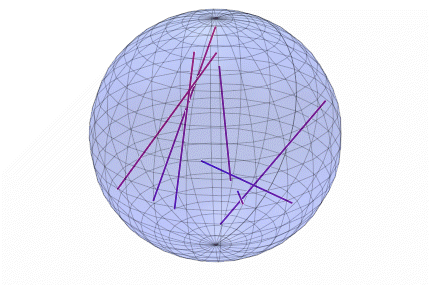Here we look at the average distance between two points inside the unit sphere.
Here are the results of ![]() trials repeated
trials repeated ![]() times:
times:
![]()
If ![]() ,
, ![]() , and
, and ![]() are picked uniformly in the intervals
are picked uniformly in the intervals
![]()
then as was the case in the circle, the spherical points ![]() in the unit sphere tend to be close to the origin. Assume that
in the unit sphere tend to be close to the origin. Assume that ![]() ,
, ![]() , and
, and ![]() are uniformly in the intervals
are uniformly in the intervals ![]() ,
, ![]() , and
, and ![]() . Then the points
. Then the points ![]() given by
given by
![Rendered by QuickLaTeX.com \begin{eqnarray*}\rho &=&\sqrt[3]{r} \\\theta &=&2\pi s \\\phi &=&\arccos \left( 2s-1\right)\end{eqnarray*}](https://darelhardy.com/wp-content/ql-cache/quicklatex.com-95bba503f551678314fb5c7c492a7f3c_l3.png)
are uniformly distributed in the unit sphere.
Why the cube root? To get the points uniformly distributed, the value of ![]()
corresponding to ![]() should yield a sphere whose volume is half the volume of the unit sphere. Indeed,
should yield a sphere whose volume is half the volume of the unit sphere. Indeed,
![]()
is half the volume of the unit sphere.
To find an integral that represents the average distance between to points in the unit sphere, assume that one of the points is on the positive ![]() -axis, so the point
-axis, so the point ![]() where
where ![]() is randomly distributed in the unit interval. Pick
is randomly distributed in the unit interval. Pick ![]() ,
, ![]() , and
, and ![]() in the unit interval, then set
in the unit interval, then set ![]() ,
, ![]() ,
, ![]() . The second point is given by
. The second point is given by
![Rendered by QuickLaTeX.com \begin{eqnarray*}x &=&\rho \sin \phi \cos \theta =\sqrt[3]{t}2\sqrt{s-s^{2}}\cos 2\pi r \\y &=&\rho \sin \phi \sin \theta =\sqrt[3]{t}2\sqrt{s-s^{2}}\sin 2\pi r \\z &=&\rho \cos \phi =\sqrt[3]{t}\left( 2s-1\right)\end{eqnarray*}](https://darelhardy.com/wp-content/ql-cache/quicklatex.com-6b1f0bb626aa2999c5edbbcc639350ac_l3.png)
Then the square of the distance between the two points is
![]()
![]()
and the average distance is given by
![Rendered by QuickLaTeX.com \begin{eqnarray*}&&\int_{0}^{1}\int_{0}^{1}\int_{0}^{1}\sqrt{4\sqrt[3]{t}^{2}\left(s-s^{2}\right) +\left( \sqrt[3]{t}\left( 2s-1\right) -\sqrt[3]{v}\right) ^{2}}\,ds\,dt\,dv \\&=&\frac{36}{35}\approx 1.\,028\,571\,429\end{eqnarray*}](https://darelhardy.com/wp-content/ql-cache/quicklatex.com-16e2595dc6089e420c41ddbd2aadc434_l3.png)

